Combining and leveling cards = more power and more abilities. Community Engage Challenge (Eng/Esp)
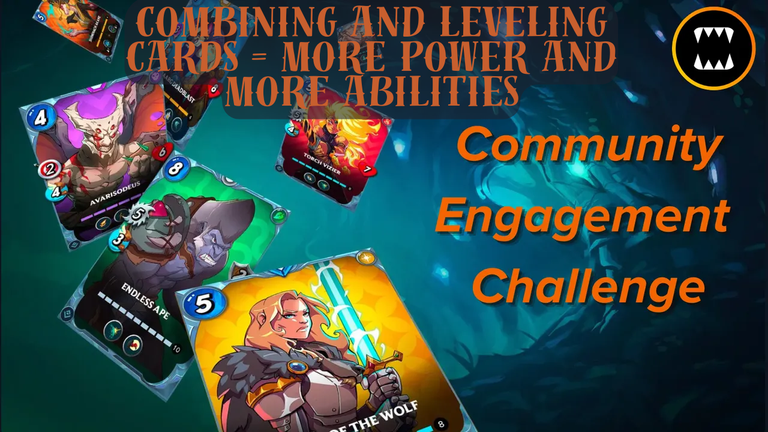

English Version
Hello citizens of Pretoria, this will be a small guide for future companions in #splinterlands, thanks to this community engage challenge the level of the cards.
First a small introduction, when starting in the game we can interact with the base versions, the cards, these only have basic statistics and initial abilities to understand a little about the battles. But as higher leagues are reached, it is necessary to increase these statistics and gain new abilities at some levels.
Cards
The following table will show you the maximum level of a cards and in parentheses the number of copies needed to reach that level.
| Rarity | Regular | Golden |
|---|---|---|
| Common | 10(400) | 10(38) |
| Rare | 8(115) | 8(22) |
| Epic | 6(46) | 6(10) |
| Legendary | 4(11) | 4(4) |
Example of combining cards
The following will be an example of how to combine the cards when having the required number of copies, in addition to seeing the changes that will occur when doing this.
For this example, Nimbledook Explorer will be selected.

By clicking on Nimbledook, we will be able to enter and see all the copies owned.
- The first step is to select where the first arrow points, this will select all the cards (if you do not want to combine a particular one, you can uncheck it in the box).
- Now we move to the + icon indicated and click.

A small window opens where it shows at the beginning the number of cards to combine, if they are enough for the next level, and if there is any left for the next one. Additionally, we can see the changes that will occur between the current level and the one it will move to. As seen in the Nimbledook example, when going from level 4 to 5, it gains a new ability. At this point, it must be confirmed whether we want to combine the cards or not.

I hope this example on how to combine the cards helps.
Which cards to prioritize
An example is this rare summoner card Dragon Helios, in the image you can see the level of units it can use depending on the summoner's level.
In my case, I have the summoner at level 5 which allows me to use cards with a good level and maintain a good position between Silver I and Gold II league.

The units you can focus on leveling up will depend on your playstyle, but I will share some reward cards that have caught my attention, which I already have at an acceptable level and others that I seek to take a little further.
- In the fire element are the following; Drybone Megalodon and Chaos Evoker.
Drybone is a good option for offense, at level 1 it can be combined with other cards that cannot attack from the second position (giving them that ability) and at level 4 it gains the retaliation ability.
Chaos Evoker has a magical attack and the explosion ability, but it stands out even more when it reaches level 5 and gains the ambush ability.


- In the water element, I highlight Commander Slade, a good tank with interesting abilities, but it gets stronger from level 4.
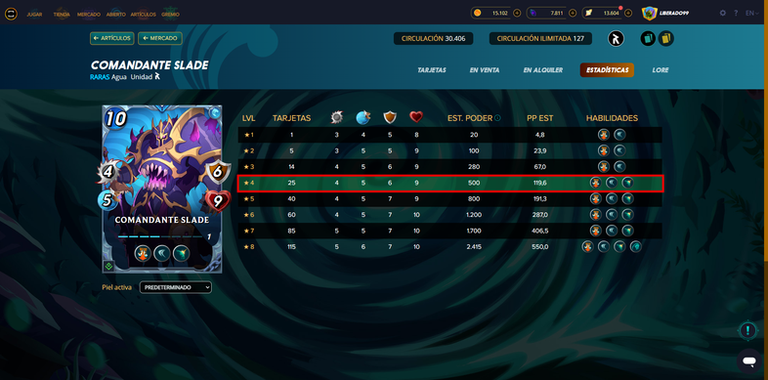
- The earth element has several excellent options to focus on leveling up, I show you one of them:
Quilliun Legionary has a ranged attack, but from level 1 it can attack from the first position and just by reaching level 2 it gains a very good thorns ability to counterattack melee opponents who manage to hit it.
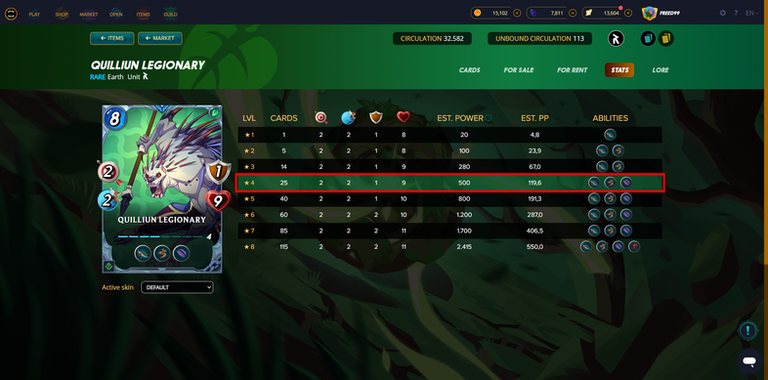
- Death is an element that surprised me with this card, Arachne has been a savior on several occasions with her ability to heal all units (it has a cost, but it's worth it), I suggest trying to take her to level 3.
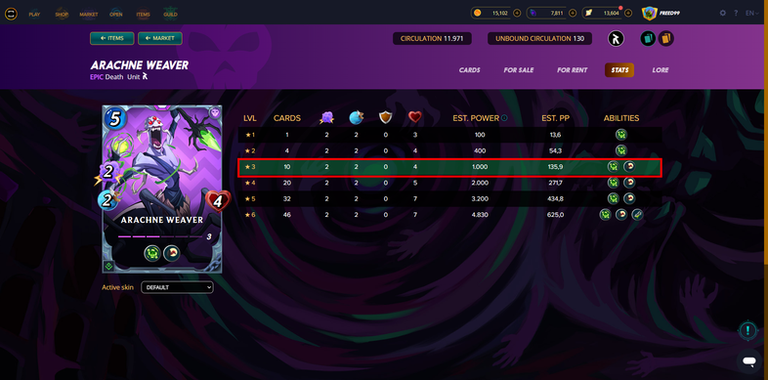
- The life element has a very crazy card, Olivia and her mimic ability gained at level 2, make battles exciting and challenging because you don't know what ability she will gain with each round.
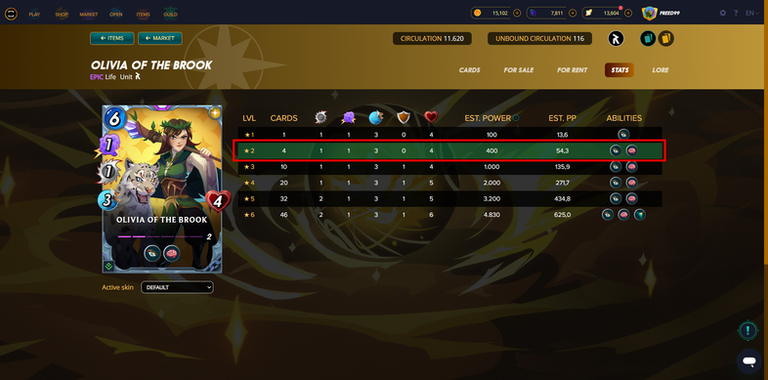
How to obtain cards
Reward cards can be obtained at the glint store, the market, or by winning them in chests when you surpass a league.
Gladius cards are acquired at the guild store.
The importance of level in the lands
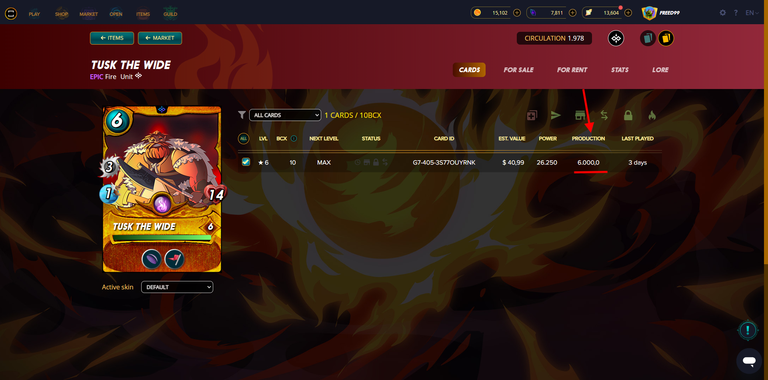

Versión en Español
Hola habitantes de pretoria, esta será una pequeña guía para los futuros compañeros en #splinterlands, gracias a este community engage challenge el nivel de las cartas.
Primero una pequeña introducción, al empezar en el juego podemos interactuar con las versiones base, las cartas, estas solo cuentan con estadísticas básicas y habilidades iniciales para entender un poco sobre las batallas. Pero a medida que se alcanzan ligas superiores es necesario subir estas estadísticas y ganar en algunos niveles nuevas habilidades.
Cartas
La siguiente tabla les mostrará el nivel máximo de una carta y en paréntesis el número de copias necesarias para alcanzar ese nivel.
| Rareza | Regular | Dorada |
|---|---|---|
| Común | 10(400) | 10(38) |
| Rara | 8(115) | 8(22) |
| Épica | 6(46) | 6(10) |
| Legendaria | 4(11) | 4(4) |
Ejemplo de combinar cartas
El siguiente será un ejemplo de como combinar las cartas al tener el número de copias requeridas, además de ver los cambios que tendrá al hacer esto.
Para este ejemplo se seleccionará a Nimbledook Explorer.

Al realizar click en Nimbledook podremos ingresar y ver todas las copias que se poseen.
- El primer paso es seleccionar donde señala la primera flecha, esto seleccionara todas las cartas (si no quieres combinar alguna en especia, puedes quitarle el check en la casilla).
- Ahora pasamos al icono de + señalado y damos click.

Se abre una pequeña ventana donde se muestra al inicio el número de cartas a combinar, si son suficientes para el siguiente nivel y si sobra alguna para el siguiente. Además, podemos ver los cambios que tendrá entre el nivel actual y al que pasará. Como se puede ver en el ejemplo de Nimbledook al pasar del nivel 4 al 5 gana una nueva habilidad. En este punto se debe confirmar si deseamos o no combinar las cartas.

Espero que este ejemplo de como combinar las cartas.
Qué cartas priorizar
Un ejemplo es esta carta rara del invocador dragón Helios, en la imagen puedes ver que el nivel de unidades que puede usar dependiendo del nivel del invocador.
En mi caso poseo el invocador en nivel 5 que me permite usar cartas con buen nivel y sostenerme en buen puesto entre la liga plata I y oro II.

Las unidades en las que puedes enfocarte en subir de nivel dependerá de tu estilo de juego, pero te compartiré algunas cartas rewards que me han llamado la atención, las cuales ya poseo en un nivel aceptable y otras que busco llevarlas un poco más allá.
- En el elemento fuego son las siguientes; Drybone Megalodon y Chaos Evoker.
Drybone es una buena opción para la ofensiva, al estar en el nivel 1 puede combinarse con otras cartas que no puedan atacar desde segunda posición (otorgándoles esa habilidad) y al estar en nivel 4 gana la habilidad retaliación.
Chaos Evoker posee un ataque mágico y la habilidad explosión, pero destaca aún más cuando llega al nivel 5 y obtiene la habilidad de emboscar.


- En el elemento agua destaco al Comandante Slade, un buen tanque que tiene habilidades interesantes, pero que se va potenciando desde el nivel 4.

- El elemento tierra tiene varias excelentes opciones para buscar subir de nivel, les muestro una de ellas:
Quilliun Legionary posee un ataque a distancia, pero desde nivel 1 puede atacar desde la primera posición y solo con llegar al nivel 2 gana una muy buena habilidad espinas para contraatacar a los oponentes cuerpo a cuerpo que logren golpearlo

- Muerte es un elemento que me sorprendió con esta carta, Arachne ha sido un salvador en varias ocasiones con su habilidad de curar a todas las unidades (tiene un costo, pero lo vale), sugiero intentar llevarla al nivel 3.

- El elemento vida tiene una carta muy loca, Olivia y su habilidad mímica que gana en el nivel 2, hace que las batallas sean llamativas y difíciles porque no sabes que habilidad ganara con cada round.

Como obtener cartas
Las cartas rewards puedes conseguirlas en la tienda glint, el mercado o ganarlas en los cofres cuando superas una liga.
Las cartas gladius se adquieren en la tienda del gremio.
La importancia del nivel en las tierras


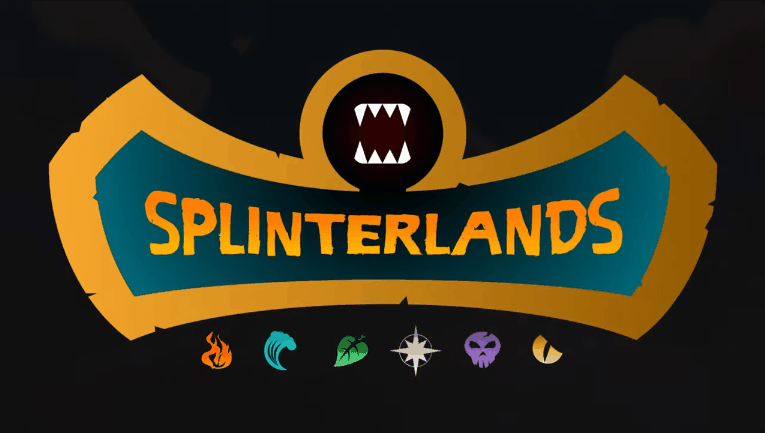
Imágenes obtenidas del discord de Splinterlands y
NFTGame Latino. Editadas en Canva.
Thank you for taking the time to read me.
Images obtained from the discord of Splinterlands
and NFTGame Latino.
Edited in Canva.
Translated in the tool Hive translator

Thanks for sharing! - @mango-juice

♦️ You got 0.01 FELT for sharing high vibes on Hive.
📋♦️ FELT Info
'It always seems impossible until it's done' - Nelson Mandela | Keep pushing 💪